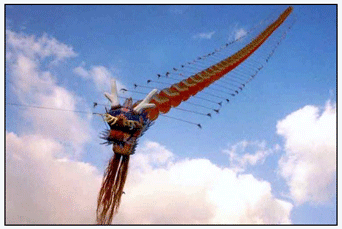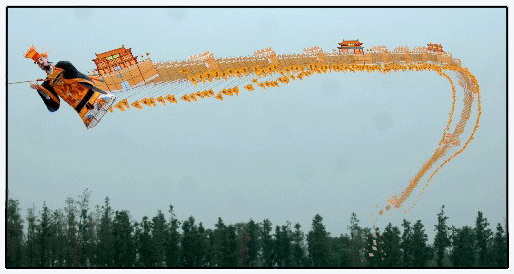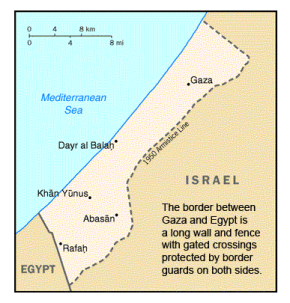Chinese Centipede Kites - The Whole is Greater Than the Sum of Its Parts!
China is viewed as one of two possible locations where kites originated thousands of years ago.
The artistry and structure of Chinese kites is unique in the world. Using materials native to China, the early kite crafters developed unique skills in shaving and shaping bamboo into diverse shapes and framing structures. The development of unique and strong papers for sails combined with specialized colored inks allowed images to be painted on the sails by Chinese artists and artisans. This combination of creatively shaped and strong kites created some of the most amazing tethered flying devices in the world.
 One type of Chinese kite links many similar segments into a train-like configuration that, when completed and raised in flight, creates a striking kite composition where the whole becomes greater than the sum of its individual parts.
One type of Chinese kite links many similar segments into a train-like configuration that, when completed and raised in flight, creates a striking kite composition where the whole becomes greater than the sum of its individual parts.
This genre of kite is known as a 'centipede' kite. Similar in some ways to a kite train, the centipede kite provides one striking difference when viewed in flight: -the total visual effect of its many parts combine to create a single, stunning image in the sky.
Two dramatic examples of this type of kite are the famous Chinese dragon kites and a recent iteration, the Great Wall of China kite.
________________________________________________________________________________
Chinese Dragon Kite:

The Chinese dragon kite has a long history that is tied to the symbolic importance of the dragon in the cultural lore of the nation. The dragon has long been viewed as a potent symbol of auspicious power in Chinese art and folk tales. The dragon is deeply entwined in Chinese culture and its meanings are deep and varied depending on the geographical region and the era of Chinese history.
With its embodiment in literature and art, it was to be expected that symbolic representations of the dragon would take flight in Chinese skies. There seems to be no precise information to suggest a date that has been historically established to confirm when the first Chinese dragon kites took to the skies, or in which exact area of the country they were first created and flown.
However, the Chinese dragon kite is an arresting and striking visual display when it is launched at any modern kite festival. The color, intricate construction and repetition of the segments of its body undulating in the breeze as it lifts skyward from its imposing head to its far off tail are simply captivating.
This kite is known as a "centipede" type of kite in that the repeated segments that follow behind the dragon's head are all identical in size and shape and are linked to make the dragon's body form, much as a centipede has a distinct head followed by many similar segments to its body. As with the centipede, the dragon kite as a visual whole is much greater than the sum of its individual parts.
___________________________________________________________________________________________
The Great Wall of China Kite:
A very recent kite that made the global news, is the kite that represents the Great Wall of China. Although not in the shape of the traditional Chinese dragon kite, this kite has all the characteristics of a 'centipede kite' form: multiple repeated segments that are attached to a lead section. When combined, all these elements provide a total, integrated kite image in the sky.

This kite was constructed during a three year period from 2006 to 2008. It was flown for the first time on June 22, 2008. The kite was crafted by Zhang Tianwei, a master in kite design. Composed of two parts, the kite had a portrait of Qin Shihuang leading the head position, followed by a more-than-100-meter micro great wall. The giant kite is 130 metres in length and 12 kilograms in weight.. Due to its heavy weight, the kite needs at least 10 people to fly it in winds of 12 to 20 kph.
Qin Shihuang was the first emperor of China who founded Qin Dynasty after conquering six other countries in the Warring States Period. He was also the man who conceived of and started the building of the Great Wall to fend off foreign invasions. Kite creator Tianwei felt that an image of the Great Wall could be recreated in a kite that would reach off into the distance and undulate in the breeze just as the physical Wall itself rambles over varying terrain in China.
Single Kite or Train of Kites?

The Chinese 'centipede' type of kite is considered to be one single kite, an amalgam of segments creating a single visual entity. The two kites described and shown above are perfect examples of this.
Typically a 'train' of kites embodies a linked line of kites that are the exactly the same which do not suggest one single visual concept theme.
An example of a kite train is shown to the right. The kite train genre features all kites, including the lead kite, made of the same design structure.
Although the visual effect in the sky is usually quite arresting, it is very different from the effect created by a 'centipede' type kite where the entire array of similar kite elements evokes a collective idea that is greater than that created by the string of kites in a typical kite train.
The train of kites shown flying above was designed and built by the author.
References and Citations:
1. Background information on dragons and their role in the culture of China is from Wikipedia, The Free Encyclopedia.
2. Image of Chinese dragon kite, of centipede variety, is from The Dragon Cave web site.
Videos of Chinese Centipede (Dragon) Kites:
Since writing this article, I have had several requests for more information on kite trains and, in particular, the Chinese centipede/dragon type kites.
Two video resources that provide insight into these magnificent kites are provided here.
Making a kite of this type is very time consuming. They are among the most beautiful kites in the world. Their long history and link to the culture of China ensures that these kites attract much attention wherever they are flown.
Magenn Kite Rotor Flies at Kite Festival
The Magenn Kite Rotor, a prototype of the Magnus Effect power generating kite, was premiered at the 2006 Canal Days Kite Festival in Port Colborne, ON.
The video below was taken at the Festival in August of 2006 by Carlos Simoes of the Kitchener-Waterloo Wind Climbers Kite Club. Appreciation is extended to Carlos for permitting the video to be displayed here.
For additional information on this kite, the following articles provide more complete information:
- Rotor Kites Move From Toy Novelty to High Tech Power Generation
- Interview with Inventor of Magenn Kite Rotor Generator
- Magenn Power Inc. website (complete, up-to-date information on the Magenn project)
Kites Soar Above Political Turmoil
 In one of the most dramatic recent examples of kites bridging geo-political divisions, comes a story from the border between Egyptand the Gaza strip in Palestinian territory.
In one of the most dramatic recent examples of kites bridging geo-political divisions, comes a story from the border between Egyptand the Gaza strip in Palestinian territory.
A news report by journalist Mohammed Omer, on the web site of the Inter Press Service International Association located in Rome, Italy, shows the power of kites to focus people on matters other than war and widely differing politics.
The story, entitled "Kites Rise Above Divisions" outlines how two young boys, one in Egypt and the other in Gaza, are able to reach above the dividing wall of the border and challenge one another in a test of skill and maneuverability. Even though the boys cannot see one another, as they look skyward they are able to recognize one another's kites by their construction and the approximate place on the ground from which they are flown.
Differing economic conditions point are still visible in the sky, Mohammed Omer notes, as the sails on kites from Gaza are made of newspaper and plastic bags while the kites of the Egyptian boys are made of traditional materials like colorful tissue paper and glue.
In the sky, the challenge is on - boys playing with one another in a test of wills and wits with a simple desire to enjoy the opportunities of a playful diversion and better a friendly adversary in a non-life threatening manner.
Mohammed Omer's story is not an isolated incident of kites soaring above the border with children engaging in skillful competition in the sky. The occurrence of kite flying contests between children from Gaza and Egypt happens on a regular basis.
In a dramatic blog posting on May 17, 2007 by Laila El-Haddad, a journalist mother who divides her time between Gaza and the United States, the contrasts between war and the peaceful activity of children flying kites on both sides of the Egypt-Gaza border are clearly outlined. Laila El-Haddad wrote about one such day of contrasts thus:
"After a terrifying 24 hours, we awoke this morning to sporadic gunfire, and ghostly streets."
"Though the gunfire had subsided, the gunmen were still patrolling the streets, each this time casually manning their own turf, masked and fully armed."
"We decided to avoid the town centre, and headed instead to film near the border area along Rafah’s edge. Young children blissfully flew handmade kites above the iron wall separating them from the Egyptian Rafah. Their "atbaq" flirted in the infinite sky above with kites flying their way from the Egyptian side. "We play a game with the Egyptian kids" they explained of their unseen counterparts. "We meet here, through our kites, and see who can catch the other's kites quicker by entangling. So far we're winning-we've got 14 Egyptian kites" he announced proudly."
"The children are small enough that they can wiggle their way through the cracks of the large iron gates along the wall-where once Merkava tanks made their unwelcome entrance to battered camps here. And so they can call out to their Egyptian friends, and learn their names and new kite flying techniques."
So it is with kites - their ability to reach into the sky, to ride on the wind, to challenge each flyer to master the currents and the capabilities of their own tethered aircraft will always rise above the seemingly intractible divisions of geopolitical differences.
It makes one wonder if we should have more adults flying kites rather than grinding on with the same old politics.
At least while flying a kite they would look up, see the sky and feel the pull of the wind. The sky knows no borders and the wind does not stop at border crossings. The friendly challenges of skill allows one to learn of your counterpart in terms other than politics and opens a window on the possibility of seeing your opponent as an individual, rather than a stereotypical member of group politics. Perhaps there are serious lessons to be learned through kites!
__________________
Notes:
- Kites flown by children in Egypt and Gaza tend to be of the generic, maneuverable single line 'fighter kite' type. Usually the sail is made of tissue paper with bamboo or similar shapable wooden spars for framing. Sometimes, newspaper or plastic bags are substituted for sail material if the more expensive tissue paper is not available.
- Kites made of more modern ripstop sailcloth material can sometimes be found in the sea coast tourist areas of Egypt.
- The Egyptian sea coast resorts are popular spots for tourists who engage in the expensive sport of kite boarding using modern kites by Naish and designs by Peter Lynn.
Updated Time Lines of Kite History
 The Time Lines of Kite History, an often visited feature of the Best-Breezes web site, were updated to Version 2.1 after extensive review of the original time line research. The review and update took a period of six months as new source material was reviewed and additional conversations were held with kite history experts.
The Time Lines of Kite History, an often visited feature of the Best-Breezes web site, were updated to Version 2.1 after extensive review of the original time line research. The review and update took a period of six months as new source material was reviewed and additional conversations were held with kite history experts.
Although Version 2.1 is as up-to-date as possible, it is anticipated that more revisions and updates will be made in the months and years ahead.
I welcome conversation and dialogue on this time line and hope that you will share any possible findings of yours which may lead to new inclusions or corrections on those items that, although carefully researched, may still need some detailed fine tuning.
Throughout time, the kite has been an object of great fascination and value to human kind. The Time Lines of Kite History presented here are intended to help preserve this history for those who are interested in all aspects and applications of kites over the years.
Addition of Kite History Fact of the Day
 Although it has been a few months since my last post to the Best-Breezes blog section of this web site, a lot has been going on behind the scenes.
Although it has been a few months since my last post to the Best-Breezes blog section of this web site, a lot has been going on behind the scenes.
Extensive work has been done to improve the Time Lines of Kite History and updated versions of these much visited resources on the site should be posted by the end of May. Numerous typographical corrections have been made to make the information much more accurate. In addition, new events have been added to the timelines as the verification process for them ensured that they could be entered into the chronicle.
One interesting off shoot of this work has been the inclusion of a new page on the site entitled Kite History FACT OF THE DAY.
Using some of the facts in the Time Lines of Kite History data base, a JavaScript has been added to display a new fact each time visitors access this part of the site. It is hoped that these interesting facts will capture your imagination and help to enhance your experience on this web site.
Other detailed research has been going on in these past months on the following topics:
- kite pioneer Silas J. Conyne of Chicago, Illinois
- kite pioneer Major B.F.S. Baden-Powell of Great Britain
- the principles of kite flight (some of the research gathered on this topic will improve the section on The Science of Kite Flight)
- building a data base of old and historic kite photos that will be displayed in a random fashion of the home page of the web site.




